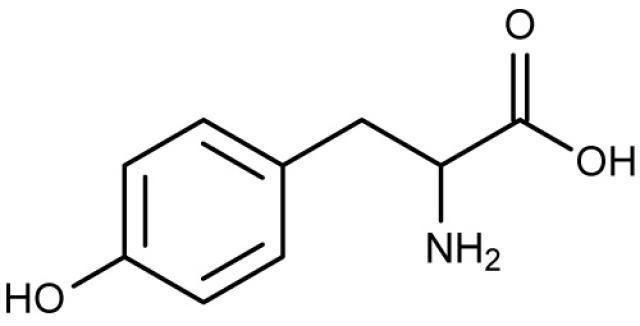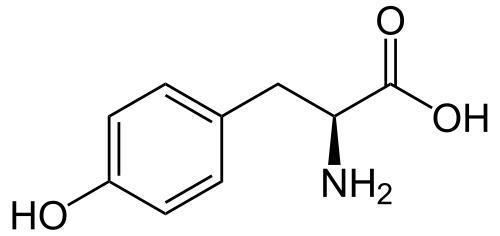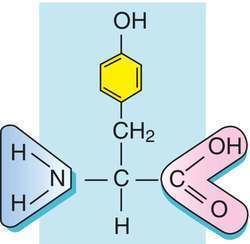Formula C9H11NO3 IUPAC ID Tyrosine | Molar mass 181.19 g/mol | |
 | ||
Thermodynamicdata Phase behavioursolid–liquid–gas | ||
Tyrosine an amino acid for depression and energy
Tyrosine (Tyr or Y) or 4-hydroxyphenylalanine is one of the 20 standard amino acids that are used by cells to synthesize proteins. It is a non-essential amino acid with a polar side group. Its codons are UAC and UAU. The word "tyrosine" is from the Greek tyros, meaning cheese, as it was first discovered in 1846 by German chemist Justus von Liebig in the protein casein from cheese. It is called tyrosyl when referred to as a functional group or side chain. Tyrosine is a hydrophilic amino acid and is significantly more soluble in water than its precursor, phenylalanine, due to the thermodynamic favorability of the hydrogen bonding between the hydroxyl group of one molecule of tyrosine and the carboxyl group of another.
Contents
- Tyrosine an amino acid for depression and energy
- The benefits of l tyrosine
- Functions
- Biosynthesis
- Phosphorylation and sulfation
- Precursor to neurotransmitters and hormones
- Precursor to alkaloids
- Precursor to natural phenols
- Precursor to pigments
- Role in coenzyme Q10 synthesis
- Degradation
- Ortho and meta tyrosine
- Medical use
- Industrial synthesis
- References

The benefits of l tyrosine
Functions

Aside from being a proteinogenic amino acid, tyrosine has a special role by virtue of the phenol functionality. It occurs in proteins that are part of signal transduction processes. It functions as a receiver of phosphate groups that are transferred by way of protein kinases (so-called receptor tyrosine kinases). Phosphorylation of the hydroxyl group changes the activity of the target protein.
A tyrosine residue also plays an important role in photosynthesis. In chloroplasts (photosystem II), it acts as an electron donor in the reduction of oxidized chlorophyll. In this process, it loses the hydrogen atom of its phenolic OH-group. This radical is subsequently reduced in the photosystem II by the four core manganese clusters.
Biosynthesis

In plants and most microorganisms, tyr is produced via prephenate, an intermediate on the shikimate pathway. Prephenate is oxidatively decarboxylated with retention of the hydroxyl group to give p-hydroxyphenylpyruvate, which is transaminated using glutamate as the nitrogen source to give tyrosine and α-ketoglutarate.

Mammals synthesize tyrosine from the essential amino acid phenylalanine (phe), which is derived from food. The conversion of phe to tyr is catalyzed by the enzyme phenylalanine hydroxylase, a monooxygenase. This enzyme catalyzes the reaction causing the addition of a hydroxyl group to the end of the 6-carbon aromatic ring of phenylalanine, such that it becomes tyrosine.
Phosphorylation and sulfation

Some of the tyrosine residues can be tagged (at the hydroxyl group) with a phosphate group (phosphorylated) by protein kinases. In its phosphorylated form, tyrosine is called phosphotyrosine. Tyrosine phosphorylation is considered to be one of the key steps in signal transduction and regulation of enzymatic activity. Phosphotyrosine can be detected through specific antibodies. Tyrosine residues may also be modified by the addition of a sulfate group, a process known as tyrosine sulfation. Tyrosine sulfation is catalyzed by tyrosylprotein sulfotransferase (TPST). Like the phosphotyrosine antibodies mentioned above, antibodies have recently been described that specifically detect sulfotyrosine.
Precursor to neurotransmitters and hormones

In dopaminergic cells in the brain, tyrosine is converted to L-DOPA by the enzyme tyrosine hydroxylase (TH). TH is the rate-limiting enzyme involved in the synthesis of the neurotransmitter dopamine. Dopamine can then be converted into other catecholamines, such as norepinephrine (noradrenaline) and epinephrine (adrenaline).

The thyroid hormones triiodothyronine (T3) and thyroxine (T4) in the colloid of the thyroid also are derived from tyrosine.
Precursor to alkaloids
The latex of Papaver somniferum, the opium poppy, has been shown to convert tyrosine into the alkaloid morphine and the bio-synthetic pathway has been established from tyrosine to morphine by using Carbon-14 radio-labelled tyrosine to trace the in-vivo synthetic route.
Mescaline producing cactus bio-synthesize tyrosine into mescaline when injected with it.
Precursor to natural phenols
Tyrosine ammonia lyase (TAL) is an enzyme in the natural phenols biosynthesis pathway. It transforms L-tyrosine into p-coumaric acid.
Precursor to pigments
Tyrosine is also the precursor to the pigment melanin.
Role in coenzyme Q10 synthesis
Tyrosine (or its precursor phenylalanine) is needed to synthesize the benzoquinone structure which forms part of coenzyme Q10.
Degradation
The decomposition of L-tyrosine (syn. para-hydroxyphenylalanine) begins with an α-ketoglutarate dependent transamination through the tyrosine transaminase to para-hydroxyphenylpyruvate. The positional description para, abbreviated p, mean that the hydroxyl group and side chain on the phenyl ring are across from each other (see the illustration below).
The next oxidation step catalyzes by p-hydroxyphenylpyruvate dioxygenase and splitting off CO2 homogentisate (2,5-dihydroxyphenyl-1-acetate). In order to split the aromatic ring of homogentisate, a further dioxygenase, homogentisate 1,2-dioxygenase is required. Thereby, through the incorporation of a further O2 molecule, maleylacetoacetate is created.
Fumarylacetoacetate is created by maleylacetoacetate cis-trans-isomerase through rotation of the carboxyl group created from the hydroxyl group via oxidation. This cis-trans-isomerase contains glutathione as a coenzyme. Fumarylacetoacetate is finally split by the enzyme fumarylacetoacetate hydrolase through the addition of a water molecule.
Thereby fumarate (also a metabolite of the citric acid cycle) and acetoacetate (3-ketobutyroate) are liberated. Acetoacetate is a ketone body, which is activated with succinyl-CoA, and thereafter it can be converted into acetyl-CoA, which in turn can be oxidized by the citric acid cycle or be used for fatty acid synthesis.
Phloretic acid is also a urinary metabolite of tyrosine in rats.
Ortho- and meta-tyrosine
Three structural isomers of L-tyrosine are known. In addition to the common amino acid L-tyrosine, which is the para isomer (para-tyr, p-tyr or 4-hydroxyphenylalanine), there are two additional regioisomers, namely meta-tyrosine (also known as 3-hydroxyphenylalanine, L-m-tyrosine, and m-tyr) and ortho-tyrosine (o-tyr or 2-hydroxyphenylalanine), that occur in nature. The m-tyr and o-tyr isomers, which are rare, arise through non-enzymatic free-radical hydroxylation of phenylalanine under conditions of oxidative stress.
m-Tyrosine and analogues (rare in nature but available synthetically) have shown application in Parkinson's Disease, Alzheimer's disease and arthritis.
Medical use
Tyrosine is a precursor to neurotransmitters and increases plasma neurotransmitter levels (particularly dopamine and norepinephrine), but has little if any effect on mood in normal subjects. The effect on mood is noted in humans subjected to stressful conditions (see below).
A number of studies have found tyrosine to be useful during conditions of stress, cold, fatigue, prolonged work and sleep deprivation, with reductions in stress hormone levels, reductions in stress-induced weight loss seen in animal trials, and improvements in cognitive and physical performance seen in human trials.
Tyrosine does not seem to have any significant effect on cognitive or physical performance in normal circumstances, but does help sustain working memory better during multitasking.
Industrial synthesis
L-tyrosine and its derivatives (L-DOPA, melanin, phenylpropanoids, and others) are used in pharmaceuticals, dietary supplements, and food additives. Two methods were formerly used to manufacture L-tyrosine. The first involves the extraction of the desired amino acid from protein hydrolysates using a chemical approach. The second utilizes enzymatic synthesis from phenolics, pyruvate, and ammonia through the use of tyrosine phenol-lyase. Advances in genetic engineering and the advent of industrial fermentation have shifted the synthesis of L-tyrosine to the use of engineered strains of E. coli.
